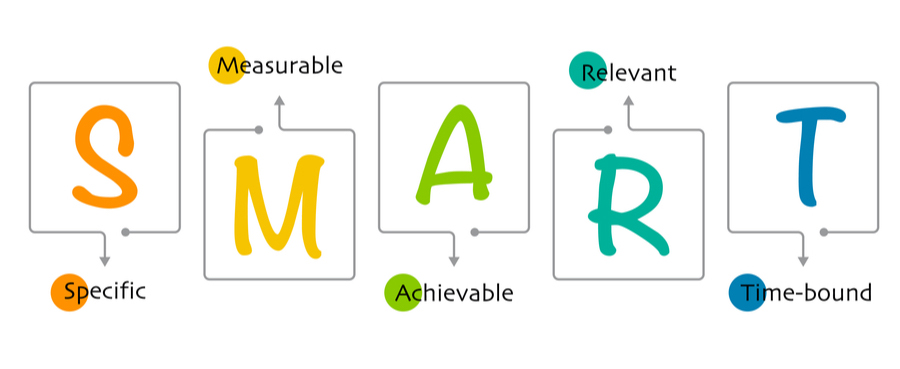Are you ready to stop setting goals because you never seem to reach them? Whether it's to lose weight, build muscle, run your first marathon, or eat a clean and healthy diet, do you find you have plenty of intention and even have the knowledge, but you tend to give up on yourself at some point? Well, that's about to change.
You've probably heard of SMART goals: specific, measurable, action-oriented, realistic, and time-bound. Maybe you've probably set them for yourself and/or others. How can you go from setting SMART goals to actually achieving them? We're going to show you.
But first, think of one of your goals, then answer the following 17 questions. Your answers to these questions will help you map out exciting and unstoppable steps (#'s 18-22) to finally get you to your goal.
Specificity
Paint a vivid picture in your head that answers the five W's:
1. What, exactly, are you aiming to achieve?
2. When will you carve out time each week to take steps toward this outcome?
3. Where will you be able to work on these actions?
4. Who will you be doing these activities with? Or, who do you need to step away from to complete these activities?
5. Why? Why? Why? Ask yourself at least three times why this is so important to you. There is no right or wrong answer, but you'll know you've found your "super-why" when you are afraid to tell someone else what the answer is.
Measurable
Measurable means focusing on objective proof that your actions are leading in the intended direction. We often avoid measures for fear we might not have changed or have changed in the opposite of our intended direction. Yet, if we commit to these measures, we can detect changes and pivot step by step as we fine-tune each week. This fine-tuning helps us stay the course. Answer the following five questions to decide on your measures, then commit to performing them. No excuses.
1. How will you know you have reached the significant outcome that matches your vision of achievement?
2. Which supporting steps or weekly actions can you track?
3. When will you examine your measures to decide if they align with your intended direction?
4. How will you pivot your plan if your measures are different than you had planned?
5. Which measures carry the most meaning, and why?

Action-Oriented
The actions answer to the "how" aspect. We can want an outcome, but it only becomes real if we know at least some of the steps to move forward from where we are today. Answer the following five questions to add clarity to your "how."
6. How much knowledge do you have on the steps you need to take?
7. Who will you contact to fill knowledge gaps?
8. When will you create time to connect with those that will help you?
9. What resources do you need? Resources include time, space, finances, equipment, people, and perhaps technology.
10. When will you start taking consistent actions toward this goal?
Realistic
When considering what is realistic, we often stop at the intuition of, "I think I could do that." Then we try and sometimes find ourselves making excuses and becoming less frequent in actions toward the goal. Often, we don't even know why excuses like "I'm tired," or "I just don't want to do that anymore," start surfacing. So let's examine a new take on what is realistic by seeing what is congruent with your lifestyle. Ask yourself the following seven questions to explore your goal and lifestyle congruence:
11. How exciting is this goal?
12. What are you giving up to get to the outcome?
13. Are the rewards greater than the risks?
14. How ready are your body and mind to support the effort?
15. Is the goal within your locus of control?
16. Is the goal congruent with your other goals and values?
17. Is this goal one step up from where you are today?

Time-Bound
After you answer all of the above questions, map your result out on the calendar with the following five steps:
18. Put the steps on the calendar (i.e. block out time for workouts, meal prep, etc..)
19. Schedule makeup days.
20. Cross out vacations and other time away.
21. Set the realistic re-measurement days.
22. If the SMART goal is greater than 30 days away, add smaller SMART goals.
Now that you've revamped your SMART goal, share it! Share it with us, share it with those you love, and build your accountability tribe that supports your sticky SMART goal and unstoppable success!
About the Author: Dr. Meredith Butulis, creator of the ISSA Fitness Comeback Coach Certification (online), is a Sports Medicine Physical Therapist, NSCA Certified Strength and Conditioning Coach, ACSM Certified Exercise Physiologist, NASM Certified Personal Trainer, and Precision Nutrition Certified Nutrition Coach in practice since 2002. She consistently walks the talk as a fitness, physique, and OCR world-level competitor and lifestyle transformer since 2006, celebrating many wins along the way. Want more total fitness lifestyle inspiration and interaction? Follow Dr. Meredith on Instagram @Dr.MeredithButulis or join the free “Fitness Focus Fuel” Facebook Group.









